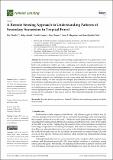A remote sensing approach to understanding patterns of secondary succession in tropical forest
Abstract
Biodiversity monitoring and understanding ecological processes on a global scale is a major challenge for biodiversity conservation. Field assessments commonly used to assess patterns of biodiversity and habitat condition are costly, challenging, and restricted to small spatial scales. As ecosystems face increasing anthropogenic pressures, it is important that we find ways to assess patterns of biodiversity more efficiently. Remote sensing has the potential to support understanding of landscape-level ecological processes. In this study, we considered cacao agroforests at different stages of secondary succession, and primary forest in the Northern Range of Trinidad, West Indies. We assessed changes in tree biodiversity over succession using both field data, and data derived from remote sensing. We then evaluated the strengths and limitations of each method, exploring the potential for expanding field data by using remote sensing techniques to investigate landscape-level patterns of forest condition and regeneration. Remote sensing and field data provided different insights into tree species compositional changes, and patterns of alpha- and beta-diversity. The results highlight the potential of remote sensing for detecting patterns of compositional change in forests, and for expanding on field data in order to better understand landscape-level patterns of forest diversity.
Citation
Chraibi , E , Arnold , H , Luque , S , Deacon , A , Magurran , A E & Féret , J-B 2021 , ' A remote sensing approach to understanding patterns of secondary succession in tropical forest ' , Remote Sensing , vol. 13 , no. 11 , 2148 . https://doi.org/10.3390/rs13112148
Publication
Remote Sensing
Status
Peer reviewed
ISSN
2072-4292Type
Journal article
Description
Funding: E. Chraibi and J.-B. Féret acknowledge financial support from Agence Nationale de la Recherche (BioCop project—ANR-17-CE32-0001-01). A.E. Magurran acknowledges support from the Leverhulme Trust (RPG-2019-402).Collections
Items in the St Andrews Research Repository are protected by copyright, with all rights reserved, unless otherwise indicated.

